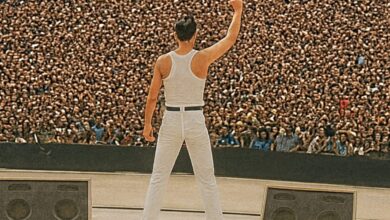Erin Fox and The Rock Orchestra Deliver the Most Powerful Rendition of The Cranberries’ “Zombie”
When Erin Fox and The Rock Orchestra took the stage to perform *“Zombie,”* it wasn’t just another live show—it was a musical rebirth of one of the 1990s’ most haunting anthems. The lights dimmed, the audience hushed, and as the first notes began to echo through the hall, everyone knew they were about to witness something special. Erin’s voice entered, steady yet filled with emotion, while the orchestra built a slow, thunderous foundation behind her. The fusion of rock power and symphonic depth transformed the space into something otherworldly.
From the opening bars, Erin commanded attention. Her voice carried both fragility and strength, mirroring the song’s message about pain, loss, and resistance. Behind her, The Rock Orchestra’s strings swelled in harmony, intertwining with electric guitars that added grit and urgency. The combination wasn’t just sonically rich—it was emotionally overwhelming. Each note seemed to dig deeper into the meaning of *“Zombie”*, revealing layers of sorrow and defiance that audiences hadn’t heard before.
As the performance unfolded, the chemistry between Erin and the orchestra became undeniable. The violins soared as her voice cracked slightly with emotion, the cellos grounding the song’s melancholy core. When the guitars roared into the chorus, the orchestra answered in kind, matching their energy with cinematic intensity. The crowd sat motionless, transfixed by how seamlessly modern rock and classical symphony could merge into one overwhelming force.
Erin’s stage presence was magnetic. Dressed in simple, dark attire, she let the music speak for itself. There were no flashy effects—just pure, raw connection. Every lyric she delivered carried weight, every pause seemed deliberate. When she sang “In your head,” her voice trembled, filled with anguish, then erupted into power. The audience felt every word as if it were their own story being retold on stage.
The orchestra behind her wasn’t just accompaniment—it was an equal partner in storytelling. Each musician seemed to channel Erin’s energy, responding to her phrasing with delicate swells or thunderous bursts. The violins mimicked the cries of pain within the lyrics, while the percussion pounded like the heartbeat of protest. Together, they created a soundscape that was as cinematic as it was personal.
Midway through the song, the dynamics shifted. The orchestra fell to a whisper, allowing Erin’s voice to take center stage. Her delivery of the bridge was intimate—almost like a conversation with the audience. Then, without warning, the full force of the orchestra and guitars returned in unison, building to a breathtaking crescendo. It was the kind of musical eruption that sent chills through the crowd—loud, unapologetic, and cathartic.
The most striking aspect of the performance was how it honored the legacy of The Cranberries while becoming its own creation. Erin didn’t imitate Dolores O’Riordan—she paid tribute by embodying the same spirit of emotional truth. Her rendition was fierce yet respectful, her tone reverent but alive. By the final chorus, her voice soared above the orchestra like a battle cry, giving the decades-old song new life.
Visually, the stage was minimal yet atmospheric. Cool blue and gold lights washed over the musicians, shifting with the intensity of the music. As the strings and drums locked in, the lighting pulsed like a heartbeat, syncing perfectly with the rhythm. Every detail—sound, light, movement—felt meticulously crafted to draw the audience deeper into the song’s emotional core.
When the last note faded, there was a moment of silence before the eruption of applause. Audience members were visibly moved—some teary-eyed, others speechless. The performance wasn’t just heard; it was felt. That night, Erin and The Rock Orchestra didn’t just perform *“Zombie.”* They resurrected it, transforming grief into something transcendent.
In the days following the show, clips of the performance spread rapidly across social media. Viewers called it “the most powerful version of ‘Zombie’ ever performed,” and praised Erin’s voice as “hauntingly divine.” Within a week, the video had reached millions of views, sparking renewed interest in both The Rock Orchestra and The Cranberries’ original song.
Critics also took note. Music publications highlighted the performance as an example of how classical and rock elements could blend without losing authenticity. “Erin Fox doesn’t just sing the song—she embodies its pain and purpose,” one review read. Another compared her emotional delivery to the likes of Florence Welch and Amy Lee, praising the balance of strength and vulnerability in her tone.
Beyond the technical brilliance, what made this performance extraordinary was its message. *“Zombie”* has always been a protest song—a cry against violence and the loss of innocence. Erin and the orchestra amplified that message for a new generation, showing that music’s power to heal and unite remains timeless. It was as if the song’s soul had been reborn through their hands.
The Rock Orchestra’s arrangement deserves special mention. Their conductor wove tension and release with masterful precision, allowing the song to breathe before unleashing each wave of emotion. The string section became the emotional backbone, while the brass added an unexpected grandeur that made the final moments feel almost cinematic.
By the end of the night, the crowd rose to its feet in thunderous applause. Erin bowed deeply, visibly humbled. Behind her, the orchestra members exchanged knowing smiles—they had created something unforgettable. This wasn’t merely a concert—it was a communion between art, audience, and emotion.
The performance now stands as one of the defining moments in The Rock Orchestra’s history. It showcased not only Erin Fox’s powerhouse talent but also the timeless relevance of *“Zombie.”* In an era hungry for authenticity, their version reminded everyone that the most powerful music doesn’t just entertain—it connects, transforms, and transcends.





